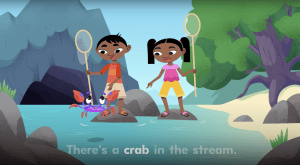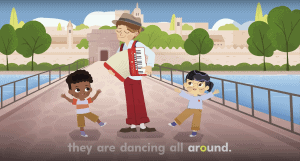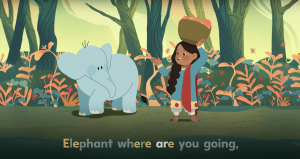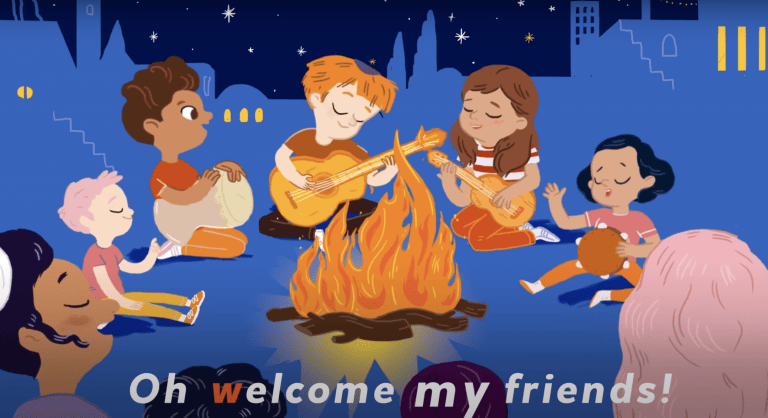 Written by Marika Ismail
Written by Marika Ismail
Director of Inclusive Curriculum at Waterford.org
My 4-year-old son Niko recently started transitional kindergarten at our local elementary school. It’s been a rough time for us, with a few tears. Some days he tells me he’s scared and misses his friends from preschool.
During the first weeks of school, Niko and I listened to “Make New Friends,” a song from Waterford’s new Sing Around the World series, in the car and at home. One line says, “Make new friends and keep the old / One is silver and the other is gold.”
After listening, we shared memories of his friends from preschool and discussed how it can take time to make new friends. Music offered us a door into the conversation about Niko’s anxiety, and it gave me an indirect way to encourage and support him as he learns new social and mindset skills in the classroom.
The Benefits of Music Include Connection
 Research shows that singing cultivates connections between adults and children. Some of my earliest memories are of listening to music in the car with my mom. My parents were divorced, and every other weekend we’d meet at a rest stop near the border of North Carolina (where I lived with my mom) and Virginia (where my dad lived) so my sister and I could spend a few days with him.
Research shows that singing cultivates connections between adults and children. Some of my earliest memories are of listening to music in the car with my mom. My parents were divorced, and every other weekend we’d meet at a rest stop near the border of North Carolina (where I lived with my mom) and Virginia (where my dad lived) so my sister and I could spend a few days with him.
One of the benefits of music, especially for children, is that it has the power to set the tone. And in my mom’s car, the tone was fun! Girls Just Wanna Have Fun, Manic Monday, Uptown Girl, and Beat It are some of the songs that helped us through that time in our lives as a family.
I grew up before streaming music. Nowadays, children have more access to music than ever before. Niko has his own playlist on my Spotify account. Just like my mom’s music helped me, listening to his favorite songs on the way to school puts Niko into a good mood for the day ahead.
Music and the Science of Reading
Can music be used to teach reading skills? According to educational research, the answer is yes. Let’s take a look at how music affects the brain.
Early childhood is a pivotal time when reading skills develop, and music can help to teach some of these skills. Research has shown a link between the music activities of preschoolers and the early development of writing and reading skills. Music builds oral language, the speaking and listening skills that contribute to literacy development. Children can also learn new vocabulary words through music.
 Formal musical training also fosters cognitive development. Children who undergo musical training have better reading ability, verbal memory, and executive functions. Verbal memory skills include remembering vocabulary definitions, character names, or key details in a story. Executive function skills, which continue developing into early adulthood, include the ability to focus, work toward goals, regulate behaviors and emotions, adapt to new situations, and more.
Formal musical training also fosters cognitive development. Children who undergo musical training have better reading ability, verbal memory, and executive functions. Verbal memory skills include remembering vocabulary definitions, character names, or key details in a story. Executive function skills, which continue developing into early adulthood, include the ability to focus, work toward goals, regulate behaviors and emotions, adapt to new situations, and more.
Along with reading, writing, and speaking skills, children hone their listening skills in early childhood. And music helps. Phonological awareness is the ability to work with sounds in spoken language, and the ability to identify rhymes is a phonological awareness skill that is honed by listening to songs. For example, my son notices and repeats the rhyming words he hears in songs and books, and that’s just one example foundational reading skills music enhances in daily life.
Listening to music also promotes an awareness of alliteration and syllable segmentation. Even teaching children to move to songs can support the development of literacy. They can walk or clap to the beat, tap or clap out the syllables, or identify the repeated sections of songs.
Music and the Windows and Mirrors Framework
In addition to the academic and emotional benefits, music is deeply rooted in culture. The music of my childhood in the 1980s was weaved into American culture, from fashion to TV to movies and beyond. The significance of my own musical memories suggests that music will one day play a powerful role in my son’s memories of his childhood as well.

Songs can be a passport around the world for young children who are just beginning to learn about different cultures and languages. It’s also important for children to see themselves and their own culture reflected in the content they see. Children need both windows into the lives of others and mirrors reflecting their own lives in order to connect to books, songs, and other learning content. This windows and mirror metaphor informs the way Waterford builds inclusive excellence into our curriculum.
Teachers can share songs that are culturally responsive with students, foster connections between them, and promote inclusion in the classroom. Consider playing songs in students’ native languages, finding out what genres of music your students know and love, or creating a class playlist that includes a diverse array of songs that reflect your students’ musical interests, cultures, and personalities.
Introducing Waterford’s Sing Around the World: An A-Z Song Series
“Make New Friends” is one of a series of animated instructional songs that I had the honor of helping bring to life in my role as Director of Inclusive Curriculum at Waterford.org. The series is called Sing Around the World, is designed for children ages 4 and up, and consists of one song for each letter of the alphabet and one series introduction song. Each song in the Sing Around the World series begins in English and is followed by the same song in the native language of the country represented.
The songs teach lowercase letter recognition and print concepts while introducing children to music from 26 cultures around the globe. Print concepts include the ideas that letters are grouped to make words, words are separated by spaces, and reading moves from left to right, and top to bottom.
When developing instructional content, we take care to ensure the instructional design is sound. For example, we highlight the target letter to support letter recognition, keep words on the screen for long enough for children to see them, and incorporate cultural elements appropriately.

Conclusion
Niko recently began coming home from school with new songs in his repertoire. He teaches me the songs he learns from his teacher, along with the hand movements that accompany them. It’s notable that what sticks in his mind are the songs – the words, melodies, rhythms, and movements.
Music is a strong tool for student engagement and active learning. I’m hopeful that as Niko grows up, music will offer more and more opportunities for us to connect and for him to connect with teachers, classmates, and cultures.
Further Reading:
Anzalone, C. “Study Finds Link Between Music and Preschoolers Reading Readiness.” University at Buffalo. January 23, 2013. https://www.buffalo.edu/news/releases/2013/01/021.html
Lee Pesky Learning Center. “Making Music: Literacy Tips for Parents.” Reading Rockets. https://www.readingrockets.org/article/making-music-literacy-tips-parents
Miendlarzewska, E.A., & Wiebke, J. T. “How musical training affects cognitive development: rhythm, reward and other modulating variables.” Frontiers in Neuroscience. January 2014. https://www.ncbi.nlm.nih.gov/pmc/articles/PMC3957486/

